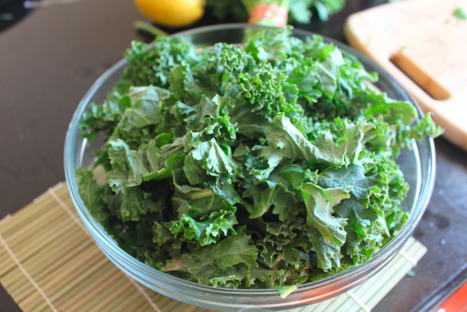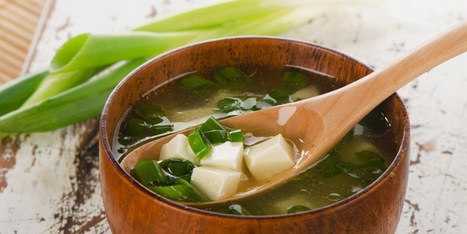 Your new post is loading...
 Your new post is loading...
Mediterranean Diet
AN ESTIMATED 86 MILLION AMERICANS ARE AT RISK FOR TYPE 2 DIABETES
But nearly 90 percent of them don’t know it.
Doctors say adhering to a Mediterranean diet may help to reverse your risk of developing Type 2 Diabetes.
The Mediterranean diet, which is especially popular from Spain and Italy to Greece and the Middle East, largely focuses on seasonal fruits and vegetables.
“It’s dark leafy greens, freshly foraged greens in all different varieties… like kale and collards and spinach and chard,” said Dahlia Shaaban, founder of Washington, D.C.-based Live Deliciously.
The majority of foods in a Mediterranean diet do come from plants, but Shaaban says to go for fish or lean proteins twice per week. Salmon and tuna, for example, contain Omega 3 Fatty Acids which promote heart and brain health.
“So you can think of crowding out your plate with more plant-based foods, then enjoying meat here and there,” explained Shaaban.
BEANS, NUTS & WHOLE GRAINS ARE EVERYDAY STAPLES IN A MEDITERRANEAN MEAL
“The grain is something you can hold onto,” said Shaaban. “Brown rice, farro, wide rice, quinoa, bulgur or cracked wheat. The most common beans you find in the Mediterranean are: lentils, chickpeas, fava beans, black eyed peas.”
The American Diabetes Association suggests using olive oil to cook instead of butter or margarine. That can help to lower cholesterol levels. And when it comes to seasoning, herbs, spices and citrus juice are better options than salt.
Finally, limit alcohol and sugar—and you’ve got the perfect blend of health-conscious choices for people managing diabetes.
“It’s not just a diet, it’s a lifestyle,” said Shaaban.
For Mediterranean-inspired recipes, visit the Live Deliciously and Live Deliciously Tribe Facebook pages.
© 2017 WFAA-TV
Whether you eat them on a casual day at home or serve them at a party, you can guarantee that almost anyone will enjoy munching on chips. Unfortunately, most chips nowadays are made with genetically engineered (GE) ingredients and mixed with trans fats and other artificial components.
Fortunately, you can still get your fix of delicious and crunchy chips without the health risks. This Simple and Crunchy Kale Chips Recipe, shows you that there’s more to kale than just salads and smoothies. With the right spices, you can transform ordinary kale into chips that are sure to pack a flavorful crunch (pun intended).
Miso has been a staple in Chinese and Japanese diets dating back approximately 2,500 years. Traced from ancient China, where it was known as hisio, a seasoning prized by aristocrats, miso was perfected in Japan from the 7th century to current day.
Today, most of the Japanese population begins their day with a warm bowl of miso soup to stimulate digestion and energize the body. When purchasing miso, avoid the pasteurized version and spend your money on the live enzyme-rich product, which is also loaded with beneficial microorganisms. As long as you choose unpasteruized miso, you will be getting the benefits of live friendly microflora for the health of your inner ecosystem.
While it was once thought that soy was the reason for the low rates of heart disease, breast and prostate cancer in Asia, more evidence is now showing us that it is the consumption of traditional fermented soy products (usually eaten every day) that are providing the real benefits. There are many types of miso, some made with just soy beans and soy koji (called Hatcho miso, a favorite in Japan) and others made with barley and rice. The key to its amazing health benefits is that it must be allowed to ferment from 3 months to 3 years which produces an enzyme-rich food. Miso is effective in detoxifying and eliminating elements that are taken into the body through industrial pollution, radioactivity and artificial chemicals in the soil and food system.
A balanced, healthy nutrition consisting of carbohydrates, proteins, and healthy fats before any exercise or physical activity can provide the body with the essential energy it needs to perform to its fullest capacity. While many athletes already follow a nutritious pre-workout diet to properly fuel their bodies at the start of their sport, many of these same individuals often struggle to continue supplying energy to their system throughout their physical routine. There’s a large variety of dietary supplements that can increase an individual’s energy during exercise and physical activities but, more and more athletes today prefer to avoid the processed options and instead seek the more natural choices to achieve these same results. Frozen grapes are a great snack to eat during workouts. Sweet and refreshing, frozen grapes can be easily carried with you in a small sandwich bag or container. They are also easy to eat on the go. Eating a single or multiple frozen grape halves during a training routine or physical exercise event can help provide you with a small dose of continuous energy as well as hydration throughout the workout. Individuals who’ve used energy gels can shift to using local, natural honey as an alternative. Honey is a natural energy booster as it’s a great source of carbohydrates and its natural sugars also play an important role in preventing fatigue during exercise. Honey is best known for it’s effectiveness in instantly boosting the endurance and performance of athletes. Finally, instead of using processed energy drinks enhanced with electrolytes, 100% natural coconut water can replace missing electrolytes much more efficiently after a long workout. Drinking coconut water during and after strenuous physical activities can quickly supply your body with electrolytes and re-hydrate you efficiently.
The foods children eat are essential towards them having the necessary amount of energy they need throughout the day. With a recorded decrease in children’s ability to concentrate, many parents are searching for natural solutions, without relying on medications, to help their kids. A child’s diet is fundamental for their growth and taking careful consideration as a parent of the types of food kids eat can make a tremendous difference on their daily performance. In order for children to be able to concentrate properly, they need to consume good quality whole foods, a balance of carbohydrates, and protein, all while in taking as little sugar as possible. While its challenging to control what children do and don’t eat when they’re away in school, ensuring that they eat a healthy breakfast can make a huge difference. Before leaving the house in the morning, make sure you try to getting your child to eat some protein for breakfast. While mixing protein powder into yogurt or a fruit smoothie is essentially healthier than the average breakfast kids normally eat, feeding your child whole foods is still a better option. A vegetable omelet is a good way of mixing a protein source with the vital vegetables they need. At the start of any kid’s day, try to avoid feeding your child sugary cereals or any kind of cereal as a matter of fact. And last but not least, always refrain your child from in taking coffee or any other sugary, caffeinated beverage in the morning. All the chemicals they consume through these type of drinks are not healthy for their growing bodies.
Nerve damage or injury can occur as a result of physical trauma or from numerous medical conditions, disorders, and dysfunctions. Common causes of nerve damage, also known as neuropathy, include metabolic disorders such as diabetes, autoimmune disorders such as arthritis, vitamin deficiencies, toxins and alcoholism, and infectious diseases. Also, physical trauma from an injury, herniated disks, or compression and surgery can also cause nerve damage. The symptoms for nerve injuries include pain and discomfort, among other impairing symptoms but, studies show that the food we consume can play an important role in treating neuropathic pain.
Often maligned for being bland, cauliflower, when prepared properly, can be flavorful as well as healthful. According to World's Healthiest Foods, cauliflower is not a well-studied vegetable on its own. However, studies of diets containing cauliflower have shown several positive health benefits as well as being linked to cancer prevention. Cauliflower is rich in vitamins C, K, and manganese, which are antioxidants that can help keep the body healthy. The vegetable is also high in fiber contents and can help promote a healthy digestion. Among many other health benefits, cauliflower also has anti-inflammatory properties and can reduce the risk or cardiovascular disease.
|
You add it to your morning cup of coffee or tea. You bake it into pastries, cakes, and cookies. You even sprinkle it all over your breakfast cereal or your oatmeal.
But that’s not all. It’s also hidden in many of our favorite “treats” that people consume on a daily basis, such as sodas, fruit juices, candies, ice cream, almost all processed foods, and even condiments like ketchup.
But how exactly does sugar work in our body, how much sugar is acceptable and what are the side effects of eating too much sugar on people’s health?
By now you may have heard the shocking news: Subway's “chicken” may contain just 50 percent chicken. The rest is filler, according to a report published by Time Magazine. According to tests performed at Trent University in Canada, the company’s chicken strips and oven-roasted chicken contained just 43 percent and 54 percent chicken DNA, respectively, consisting otherwise of soy and other filler ingredients. Subway denies the charges and has demanded a retraction from CBC Marketplace, yet admits it is “concerned by the alleged findings.” According to Subway, its chicken strips and oven-roasted chicken contain less than 1 percent soy protein. The filler, it turns out, is a very long list of ingredients, however, a majority of it is soy protein. John Coupland, president of the Institute of Food Technologists, told Time Magazine. blog picture of a green button with a phone receiver icon and 24h underneath “Based on the data, that is a surprisingly large amount of soy … And it’s astonishingly high for something that you’re supposed to think is a real, whole piece of chicken.” On average, fast food chicken contains about one-quarter less protein than home-cooked chicken breast, thanks to water infusions and fillers, and up to eight times more sodium. Moreover, as noted in the program, while you’d never expect chicken to be a source of carbohydrates, fast food chicken, such as that from Subway, contain surprisingly high amounts of refined starches and sugars.
10 Foods For Energy and Performance
High level performers are always looking for strategies that will give them an edge in their field of endeavor. Athletes want to run a split second faster and jump an inch higher while business executives want to have sharper mental clarity and improved working efficiency. Specific meal timing and superfood strategies have been shown to optimize performance and recovery.
We all want to perform at our peak no matter whether we are a teacher, stay at home mom, doctor or athlete. It is also integral that we recover fast and effectively. The goal is peak performance and quick and effective recovery so we can get up the next day and do it all over again.
Optimize Your Performance: Performance in any field depends upon high level mental activity and often kinesthetic activity whether that be running or jumping or eye-hand coordination. The keys for healthy function include good fats, anti-oxidants and clean protein sources.
Providing lots of clean healthy foods and meal timing properly can make a huge difference in your overall energy and daily performance. Use the principles in this article to help guide you in preparing your body for great energy and daily performance in your daily life.
Coconut: This superfood is loaded with medium chain triglycerides (MCT’s) that break down for energy very easily. Unlike most fat sources which consist of long chain fatty acids these MCT’s do not depend upon bile and instead go right to the liver and are metabolized immediately for energy.
Muscle cells are also able to store MCT’s and use them immediately for energy during exercise sessions.
Bone Broth Protein: Bone broth contains a wide variety of valuable nutrients including collagen, gelatin, hyaluronic acid, chondroitin sulfate, glycosamino glycans, proline, glycine, calcium, phosphorus, magnesium and potassium. These all help with the development of healthy joints, bones, ligaments and tendons as well as hair and skin (2, 3, 4, 5)
These nutrients are considered beauty foods because they help the body with proper structural alignment and beautiful skin and hair. They also help to prevent against injuries by strengthening joints, tendons and ligaments. Additionally, bone broth is great for the immune system.
If you are unable to make your own bone broth, than you can try our Bone Broth Protein which comes with the same benefits as homemade broth, but it’s even more versatile in so many recipes. Bone Broth Protein begins as a true bone broth liquid. It’s then dehydrated, making it into a concentrated source of high-quality, tasty powder.
Berries: Berries are loaded with anti-oxidants and are low in sugar. Berries contain unique phytonutrients called anthocyanin’s that give them their strong pigments and allow them to handle intense sunlight. Consuming these anthocyanin’s helps our bodies adapt to stress effectively.
Be sure to get your berries organic as the thin skin makes them susceptible to pesticides and they are highly contaminated with dangerous pesticides when produced on conventional farms.
Spinach: This superfood is loaded with blood purifying chlorophyll and the anti-oxidants lutein and zeaxanthin. Spinach also contains its own plant based steroids called phyoecdysteroids that boost the bodies ability to adapt to stress. Phytoecdysteroids are similar to insect molting hormones and have been shown to dramatically increase glucose metabolism.
This keeps blood sugar levels stable and minimizes the need for the critical fat-storage hormone insulin. Additionally, phytoecdysteroids increase human muscle tissue growth rates by 20% when applied in a culture medium.
Rice & Pea Proteins For sensitive cases where people have pronounced sensitivities I prefer to use either a brown rice or pea protein. Pea protein appears to be the most hypoallergenic of all protein powders and has a 98% absorption rate. This combination of 1% brown rice and 99% pea protein has a great blend of branched chain amino acids, lysine and arginine for lean body tissue development and good circulation
Pea & brown rice protein has also been shown to be very easy on the digestive system and the protein is fairly quickly assimilated into muscle tissue. This is important because slower digesting and assimilating proteins have a greater chance of producing gas and making one feel bloated. Most plant proteins have poor assimilation rates but pea, brown rice and hemp proteins are the rare exceptions.
These are loaded with sulfur containing amino acids like methionine and cysteine which are critical for glutathione production. They are also a rich vegetarian source of branched chain amino acids. They contain essential fatty acids and edestin and albumin which are similar to the makeup of human blood and these help with critical functions like DNA repair.
Grass-Fed Butter: Dairy from grass-fed cows is extraordinarily rich in essential fats and critical nutrients like vitamin K2 and magnesium. The best foods from this group include grass-fed butter and ghee which are loaded with anti-inflammatory fats and anti-oxidants.
Grass-fed butter and ghee are also rich in conjugated linoleic acid, which helps burn fat and is anti-carcinogenic. It is the best food source of the anti-inflammatory short chain fatty acid butyrate. Finally, it is full of choline which supports healthy brain and neurotransmitter production. I use butter and ghee generously each day. Look for Kerry Gold grass-fed butter here
Red Onions: These are loaded with the flavonoid anti-oxidant quercetin. They also contain sulfur containing amino acids that boost cysteine and glutathione production within the body. They also have chromium which helps to regulate blood sugar levels.
Grass-Fed Beef: Cows that are fed a 100% green diet are loaded with anti-oxidants like carnosine and essential fatty acids. Because cows have multiple stomachs and are able to fully digest grass (humans cannot) we are getting the benefits of this fully digested super-greens in a high protein food.
A fantastic source for grass-fed beef and pastured poultry is US Wellness Meats here
Avocados: Avocados are loaded with good fats and carotenoid anti-oxidants like lutein and zeaxanthin. It is very easy on the digestive system and helps support optimal hormone function, muscle development and exercise recovery.
Raw Chocolate: This is rich in good fats and polyphenol anti-oxidants for fuel and recovery. Chocolate contains theobromine which is a natural cardiovascular stimulant that helps improve circulation throughout the body.
Proper Meal Timing: It is best to eat light before our times of performance to keep as much energy focused on the specific performance rather than on digestion. Instead of food, turn to water, as optimal hydration correlates very strongly with great performance. I try to stay super hydrated throughout the day and notice that as my water intake drops, my energy and mental acuity declines.
After the performance we want to have our largest meal to replenish our system with nutrients. Ideally, you have your largest meal at the end of your day as opposed to the beginning of your day. This helps your body to recover from the stresses of the day. You are in a relaxed position at this point, as you no longer have to work hard and perform, so it allows you to digest and absorb the nutrients you need more effectively.
This helps to take stress off of your gut lining and improves the integrity of your digestive system. When you eat in a hurry or have a large meal before a stressful event or a busy day, you compromise your digestive system and cause more inflammation in the body.
These ideas and much more I teach in our Navigating the Ketogenic diet program. Opt-in here for more details and a FREE video training series I give you on advanced strategies to improve your performance.
Fat Burning Foods Video
Food: Diet and Nutrition for a Healthy Back
As most patients are well aware, good nutrition and a balanced diet are important components of overall health. What may surprise people with back problems is that diet, nutrition and maintaining a healthy weight also play a major role in the back - including preventing many problems and healing from injuries.
The bones, muscles and other structures in the spine need good nutrition and vitamins so that they are strong enough to support the body and to perform their other functions. Using these nutritional guidelines, patients can integrate back-friendly vitamins and nutrients into their diets. See also: Weight Loss for Back Pain Relief Choosing the Right Foods for Optimal Nutrition
Eating a balanced diet that includes the right amount and variety of vitamins and nutrients will reduce back problems by nourishing the bones, muscles, discs and other structures in the spine. Particular importance is given to calcium, which can be obtained through a variety of healthy food choices as well as nutritional supplements. See Sources of Calcium in Food
While a healthy diet calls for many vitamins and nutrients, this partial list highlights a number of healthy choices that can be directly beneficial for helping back patients.
Role of Vitamin or Nutrient Food Sources
Vitamin A:
An antioxidant that assists the immune system in fighting off diseases. It is good for the back because it helps repair tissue and in the formation of bone. It also helps the body use protein effectively.
Additionally, the body can convert beta-carotene into vitamin A. Beta-carotene can be found in dark green leafy vegetables and most orange vegetables and fruits.
It's important not to get more then the recommended daily allowance of vitamin A, as too much can promote bone fractures. Beta-carotene does not increase the risk of fracture.
Vitamin A can be found in beef, calf and chicken liver; dairy products like milk, butter, cheese and eggs; orange fruits such as apricots, nectarines and cantaloupe; orange or green vegetables such as carrots, sweet potatoes and spinach.
Vitamin B12: Necessary for healthy bone marrow and for the body - and the spine - to grow and function normally. Vitamin B12 can be found in meat products, such as liver, fish, red meat and poultry; dairy products, such as milk, yogurt and cheese; and eggs.
Vitamin C: Necessary for the development of collagen, which is an important part of the process that allows cells to be able to form into tissue. This is extremely important for healing problems caused by injured tendons, ligaments and vertebral discs, as well as for keeping bones and other tissues strong.
Vitamin C can be found in fruits, such as strawberries, kiwi fruit and citrus fruits (e.g. oranges, guavas, grapefruits) and tomatoes; many vegetables, such as broccoli, spinach, red and green peppers, sweet potatoes and white potatoes.
Vitamin D: Improves calcium absorption, which is important for the development of strong and healthy bones. Adequate calcium absorption is particularly important to help prevent development of osteoporosis, a disorder characterized by weak and brittle bones in the spine that can results in painful vertebral fractures. Vitamin D is naturally occurring in egg yolks and fish oils; also found in most brands of fortified milk in the US; can also be obtained by spending time in the sunlight.
Vitamin K: Needed for the bones to properly use calcium. The combination of vitamin K and calcium works to help bones throughout the body stay strong and healthy. Vitamin K is found in liver, pork, green leafy vegetables such as spinach, kale and broccoli, and dairy products.
Iron: Needed for cells to remain healthy as it helps them receive oxygen and get rid of carbon dioxide. It also aids in the production of myoglobin, an important element of healthy muscles that are needed to support the spine. Iron is found in meat products such as liver, pork, fish, shellfish, red meat and poultry; lentils, beans, soy, eggs, grains, and green leafy vegetables such as spinach, kale and broccoli.
Magnesium: Important for the relaxing and contracting of muscles. It also helps maintain muscle tone and bone density, which in turn can help prevent back problems. Further, it assists in the body's use of protein. Magnesium is found in whole grains and whole-grain breads, beans, seeds, nuts, potatoes, avocados, bananas, kiwi fruit, shrimp, and green leafy vegetables such as spinach, kale and broccoli.
Calcium: Essential for bone health and helps maintain the necessary level of bone mass throughout the lifespan and especially in old age. Adequate calcium intake is particularly important to help prevent development of osteoporosis, which results in weak and brittle bones in the spine that can results in painful vertebral fractures. Calcium is found in dairy products such as yogurt, cheese and especially milk; dark green leafy vegetables such as spinach, broccoli and kale; tofu, peanuts, peas, black beans and baked beans; some types of fish (salmon and sardines); a variety of other foods such as sesame seeds, blackstrap molasses, corn tortillas, almonds and brown sugar.
When introducing kids to eating vegetables, it’s important to focus on enhancing their taste. For children, the flavor of vegetables can be something different to get into. For the mean time, adding Hollandaise sauce to any type of vegetable such as cauliflower, broccoli and asparagus can complement the flavor well. Cheese sauce also works well with vegetables and its easy to make your own low-fat versions of either and still offer a tasty but healthier alternative. When cooking vegetables for children, try cooking these as to soften up the texture a bit more than usual. If you’re ever in doubt whether your children will like the taste and texture of one particular vegetable, you can always sauté these in a bit of butter, plenty of lemon, garlic powder, and/or chicken broth. After all, for children who normally aren’t accustomed to eating their vegetables, these can often appear bland in taste. Enhancing the flavor of vegetables can be a good way of ensuring your children will learn to love them. When trying to get children to eat raw vegetables, low fat ranch dip can help make these taste good for them. Once your kids begin liking to eat their vegetables, you can gradually remove the sauces and dips. Chances are, your children won’t even know the difference. Also, for many children who don’t enjoy eating their vegetables, the issue can be they’re having difficulty adjusting to the different textures of vegetables. In these instances, it’s recommended to cut and seed vegetables in order for the texture of the vegetable to be more consistent, such as removing cucumber seeds.
Drinking water should be an essential part of everyone's daily routines. The majority of the body's functions work through the water found within our system but if there's a lack of proper hydration, those functions may be greatly affected or altered. Symptoms such as headaches, lack of energy, and constipation, are some of the effects of dehydration and it's crucial to replenish the amount of water needed to maintain a healthy body.
Turmeric is an ancient root that has been used for centuries for its healing properties. Traditionally, turmeric was used in Chinese and Indian folk medicine. The benefits or this root are greatly beneficial and it is able to treat a wide variety of illnesses. Turmeric contains anti-inflammatory and antiseptic qualities which have made it an extraordinary commodity for ages. The key to Turmerics healing power is the chemical compound curcumin. Many scientific studies have been conducted to evaluate the effectiveness of the root and, although some side effects have been reported, the research has shown that turmeric and its primary component, curcumin, hold profound healing qualities that provide benefits for the entire body.
Over the years, studies have demonstrated how dark chocolate is a delicious and nutritious way to promote cardiovascular health. According to new research from Kingston University in England, a nutrient fround in cocoa beans called epicatechin, could also have tremendous benefits on the overall performance of athletes, similar to those of beetroot juice, which is a popular choice for a performance boost.
|




 Your new post is loading...
Your new post is loading...





















Doctors say adhering to a Mediterranean diet may help to reverse your risk of developing Type 2 Diabetes. For Answers to any questions you may have please call Dr. Jimenez at
915-850-0900